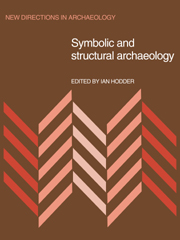Book contents
- Frontmatter
- Contents
- List of contributors
- Preface
- Part one The development of theory
- Part two The search for models
- 5 Matters material and ideal
- 6 House power: Swahili space and symbolic markers
- 7 The interpretation of spatial patterning in settlement residues
- 8 Decoration as ritual symbol: a theoretical proposal and an ethnographic study in southern Sudan
- 9 Structures and strategies: an aspect of the relationship between social hierarchy and cultural change
- 10 Mortuary practices, society and ideology: an ethnoarchaeological study
- Part three Application: the analysis of archaeological materials
- Part four Commentary
- Index
6 - House power: Swahili space and symbolic markers
Published online by Cambridge University Press: 27 February 2010
- Frontmatter
- Contents
- List of contributors
- Preface
- Part one The development of theory
- Part two The search for models
- 5 Matters material and ideal
- 6 House power: Swahili space and symbolic markers
- 7 The interpretation of spatial patterning in settlement residues
- 8 Decoration as ritual symbol: a theoretical proposal and an ethnographic study in southern Sudan
- 9 Structures and strategies: an aspect of the relationship between social hierarchy and cultural change
- 10 Mortuary practices, society and ideology: an ethnoarchaeological study
- Part three Application: the analysis of archaeological materials
- Part four Commentary
- Index
Summary
Donley introduces an ethnographic analysis of settlements and houses on the East African coast which aims to increase our knowledge of how settlement space is integrated into other aspects of life. An important component of the cultural context considered is the Islamic religion, but the particular relationships between Indian Ocean traders, middlemen and local tribes, and the use of material items in the social and economic strategies of these groups also play their parts. The specific models identified concern the use of house form and appearance in the relationships between trading groups and in the control of women. The high, blank, fortress-like exteriors of the houses protected the position of the Swahili middlemen and their control over ‘pure’ women who played an essential role in the trading system. The analysis also concerns the use of decoration to maintain the purity of women and to protect men and women from defiling activities within the house, in the innermost room and in the toilet. The use of ethnoarchaeology to study the location of material items within a symbolically organised settlement space is emphasised.
Traders have built coral settlements on the eastern coast of Africa from at least the ninth century AD until the present day. Archaeologists have excavated some of these Swahili sites and described the finds, house-plans, mosques, tombs and walls of the towns. The periods of occupation have been established by dating the imported Chinese and Islamic wares, by inscriptions and coins, and by noting the stylistic seriations (Kirkman 1964; Garlake 1966; Chittick 1967; Wilson 1979, 1980).
- Type
- Chapter
- Information
- Symbolic and Structural Archaeology , pp. 63 - 73Publisher: Cambridge University PressPrint publication year: 1982
- 51
- Cited by



